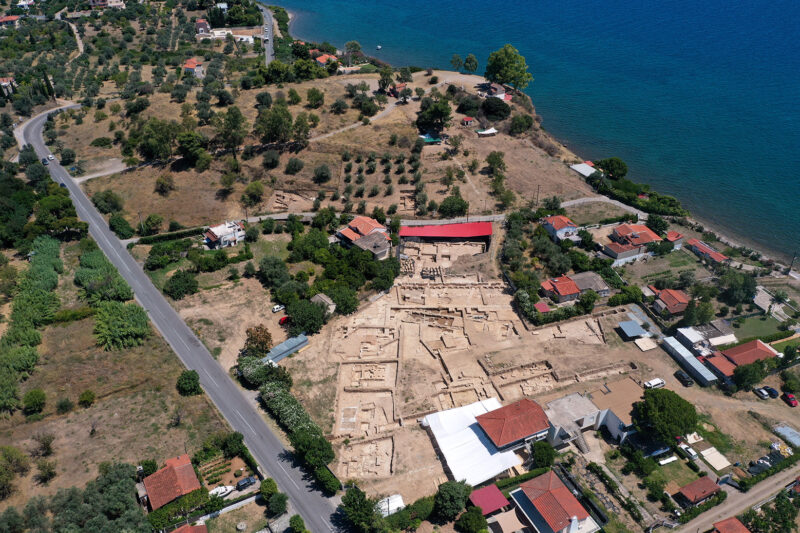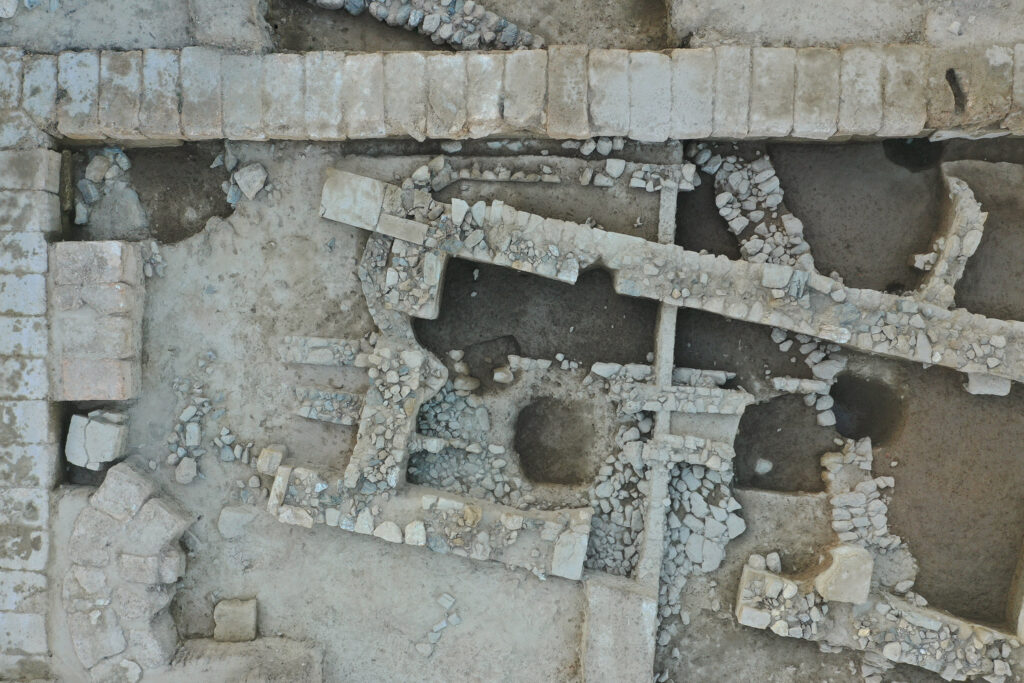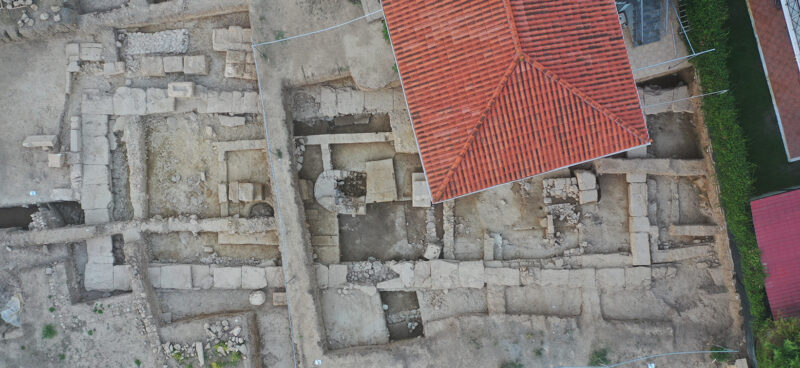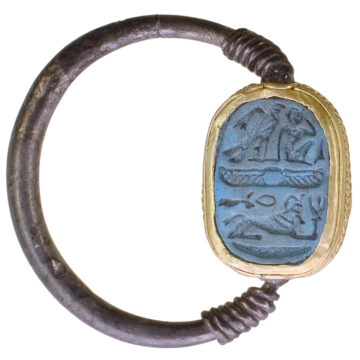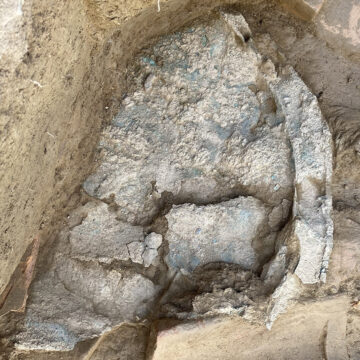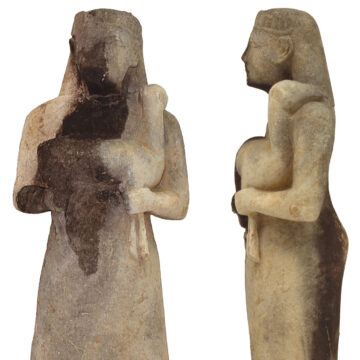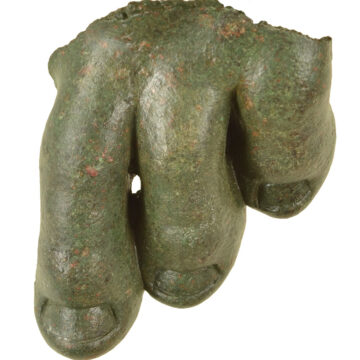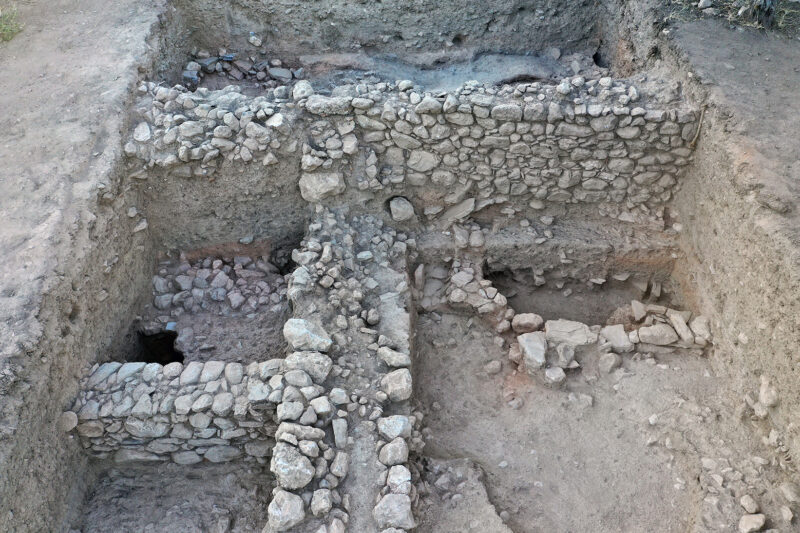New discoveries in the sanctuary of Artemis
The 2022 excavation campaign of the Swiss School of Archaeology in Greece (ESAG) at the sanctuary of Artemis Amarysia on the island of Euboea has just finished. Important discoveries were brought to light from a large team consisting of 70 archaeologists, conservators, students and workers. The excavation of the offering deposit found inside the Archaic temple was completed this year. A large number of remarkable objects were unearthed: vases, jewelry, figurines, shields, swords, as well as an exceptional stone statuette representing a female figure carrying a doe or a fawn.
Inside the sanctuary
After the discovery in recent years of a series of buildings dating to the Classical and Hellenistic periods, the project’s focus has shifted towards the study of the sanctuary’s origins (the Archaic and Geometric periods, as well as the prehistoric settlement on the hill above the sanctuary). Research now concentrates on the origins of the cult of Artemis and on the reasons that led to the foundation of the sanctuary at this location. In the summer of 2022, the Greek-Swiss excavators at the sanctuary of Artemis Amarysia made important discoveries, especially inside the second Archaic temple, whose excavation was completed (dated to ca. 525/500 BC). There, a large offering deposit, containing close to 700 objects, was revealed. These included vases, jewelry, scarab seals, terracotta figurines, two bronze shields, iron swords and double axes. Particularly noteworthy is the discovery of a stone statuette (H. 31 cm) of the early 6th century BC, representing a female figure holding a fawn or a doe, the sacred animal of Artemis. Found inside the temple, the statuette may have represented the goddess herself.
Under the temple, several structures of the Geometric and Archaic periods (8th-7th century BC) were unearthed. The presence of a horseshoe-shaped altar proves the existence of a cult at this site already in the second half of the 8th century BC. Several objects found inside the temple, such as the double iron axes, may be associated with sacrifices or to libations, such as the bronze phialai.
“Based on these discoveries, we can confirm that, following the destruction of the first Archaic temple, the site was remodeled with mud-brick wall constructions. The rich offering deposit of the last quarter of the 6th century BC is linked to the construction of the second Archaic temple”, explains Tamara Saggini, co-director of the site.
In later layers, two fragments of bronze statues were also discovered: life-size toes and part of a garment.
To the east of the temple, the excavation of a monumental building of the 7th century BC, which served both as a limit and an entrance to the sanctuary during the Archaic period, continued. Under its foundations, remains of other 8th century BC structures and a wall of impressive size, dated to the 11th century BC, were discovered.
Οn the hill of Palaeokklisies
Two new trenches were opened on the slopes of the Palaeoekklisies hill that overlooks the sanctuary, continuing the study of the area’s prehistoric phases. The sectors excavated in 2021 and 2022 confirm the presence of an important Early Bronze Age settlement at this location (3rd millennium BC). “Thanks to the objects discovered in this area, we know that its inhabitants had contacts with the Cyclades and other regions of Greece,” indicates Tobias Krapf, co-director of the site. However, the layers of the 2nd millennium BC, and especially those of the Mycenaean period, have only been partially preserved, mainly due to erosion. “The remains of the 3rd millennium are covered, in most places, by Byzantine and post-Byzantine buildings. During the Medieval period, a settlement was established on the hill, which also contributed to the destruction of earlier remains”, explains the archaeologist.
Understanding the site and the ancient landscape
The excavations of the sanctuary are also linked to an intensive survey, carried out in the vast plain that stretches between Amarynthos and the ancient city of Eretria. The aim of the ongoing survey is to better understand the position of the sanctuary in the ancient landscape, focusing on the evolution of its surrounding environment since Antiquity, the distribution of the rural habitat throughout the centuries, the cemeteries, but also the ancient communication network with particular focus on the “Sacred Way” linking the Artemision to the capital.
The research team
The team of the 2022 excavation campaign involved more than 70 archaeologists, conservators, archaeology students from Switzerland, Greece and other countries.
The research project at Amarynthos is directed by Sylvian Fachard, Director of the ESAG and Professor at the University of Lausanne, and by Dr Angeliki Simosi, Director of the Ephorate of Antiquities of Euboea.
The fieldwork was co-directed by Olga Kyriazi (Ephorate of the Antiquities of Euboea), Tobias Krapf and Tamara Saggini (Swiss School of Archaeology).
